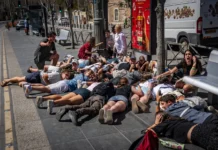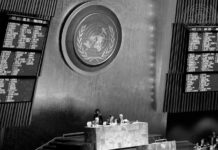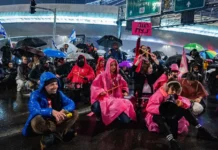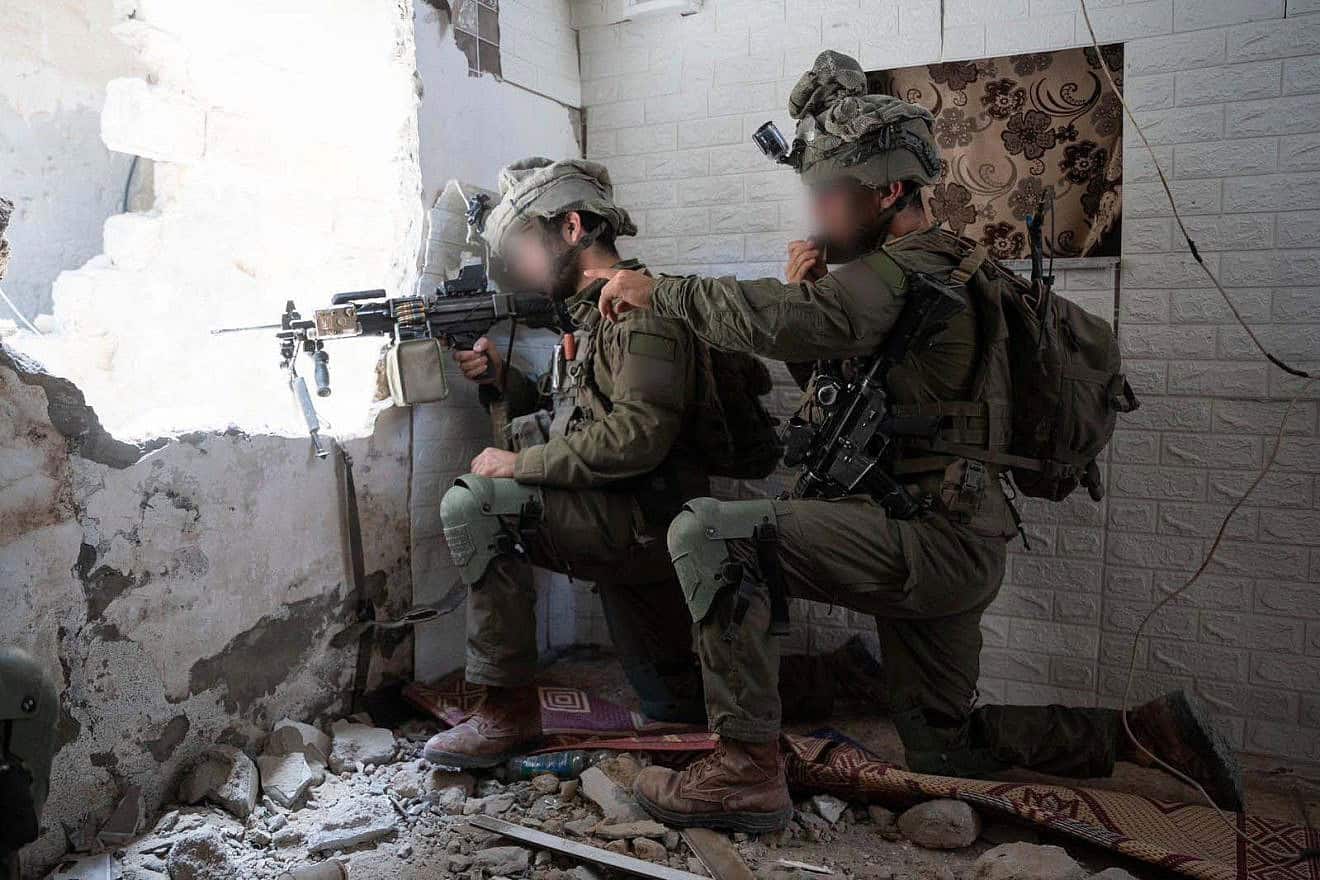The State of Israel has not known a war as long and comprehensive as the one currently raging in Gaza since the War of Independence. The 1970-1971 War of Attrition lasted about a year and a half, but did not involve the scope of forces or continuity of the current war. The First Lebanon War officially lasted only three months.
Elsewhere I called the current war Israel’s first “total war.” Total not in the sense in which the phrase is applied to the world wars of the 20th century; those wars were total in terms of general mobilization, the use of all means of war, including unconventional weapons, and the intentional targeting of civilian populations. The situation in Gaza is the opposite—it is difficult to recall another war in which one side fought while making sure to deliver supplies and humanitarian assistance to the enemy population. By use of the term I mean to highlight the contrast between this war and its goals, and the “limited war” approach that has always characterized the State of Israel.
Contrary to our original defense strategy, in this war we set as a goal not only the destruction of the Hamas army, but also the destruction of the Hamas regime.
The historical precedents are misleading. In the First Lebanon War (1982), we expelled the PLO from Lebanon and tried to stabilize Maronite rule. The PLO, as we know, was a foreign entity in Lebanon, hated by most Lebanese. The Maronites were a strong local faction and the historical rulers of Lebanon.
The Sinai operation (1956) was indeed intended to damage and overthrow the Nasser regime, but the State of Israel was only a junior partner in the Anglo-French scheme.
Both these affairs are far from the ambition of the current war, which is to remove a neighboring regime that has a strong grip on Gaza. Both those wars are also remembered as total failures.
Such historical failures highlight the logic of Israel’s modest approach to wars. Our strategy recognized Israel’s power limitations. No matter how victorious on the battlefield, Israel cannot forcefully influence the hatred and hostile intentions on the other side, much less engineer its politics. The core concept of this strategy—decisive defeat on the battlefield—was always reserved for the military dimension alone. Eliminating the immediate military threat was intended to restore security and allow Israel to avoid a prolonged war of attrition that would inevitably serve the other side.
That is exactly what Hamas was aiming for when it invaded Israel on Oct. 7. Sinwar’s strategy was to drag Israel into an attritional war that would eventually exhaust the IDF in general and the reserve forces in particular, empty the munitions stockpiles and turn the international community against Israel.
Rehab program
The goals of the current war, therefore, must by necessity extend beyond Israel’s comfort zone and the healthy understanding that characterized us in the past. Under the circumstances of October 2023, there was no better alternative. In the article “Sustainable Strategy” I analyzed the process by which we deviated from the sound basic assumptions of Israeli strategy. Wrong assumptions, primarily that the State of Israel had become a regional power, maneuvered us into a corner where we remain stuck today. I further argued that the flawed theory that we can influence our enemies’ intentions, to “deter them,” while ignoring their combat capabilities is what allowed the building up of the terrorist armies that delivered the blow in October. We now cling to the opposite error.
Much has been written about the Israeli refusal to deal with the “day after” issue. In the absence of a civilian alternative, Hamas has not only returned to control and restored its power in the neighborhoods from which the IDF has withdrawn, but it does not even feel threatened. There is, therefore, no time constraint from Hamas’s point of view, even in the context of a hostage deal.
If “total victory” means a complete and lasting removal of Hamas, it should only be understood as a long-term strategy that includes not only the military defeat of Hamas and the collapse of its government but also the stabilization and pacification of the Strip. Israel will be required to take care of the stabilization of the Strip through civil, security and economic control mechanisms.
Clear strategic thinking, not politicization of the war, is required. The analogy of the Second World War indicates what is required here. De-radicalization of Germany and Japan was possible not only thanks to their unconditional surrender but also to civil-economic measures taken.
In an attempt to correct the mistake of three decades of appeasement and deterrence strategy, Israel is now making the opposite mistake. We set a clear political war goal—eliminating Hamas rule—but continue to refuse to carry out any non-military war planning.
In principle, wars for regime change are not the correct approach for the State of Israel. But in a practical sense, we have committed ourselves to that aim by allowing the buildup of terrorist armies on our borders. This war should be considered a painful but one-time weaning process. If we have committed to this, it is necessary to see the constraint as an opportunity as well.
Resume initiative by dictating the terms of restoration
The truth must be told: The war is stuck. The pressure on all fronts—a hostage deal, international hostility, the economy, the northern front, the internal front, even munitions stockpiles—is all on Israel. The resumption of military raids in Gaza and the operation in Rafah, as important as they are, will not restore Israel’s strategic initiative. It is also absolutely clear from Hamas’s demands in negotiations that the war has moved to the stage where the parties are competing for the future political order in Gaza.
The rehabilitation of Gaza should be transformed from a Hamas demand in the negotiations, which the State of Israel is presented as refusing, to a strategic lever that will return the initiative to Israel and the pressure to Hamas.
Meanwhile, the desired end state for Israel must be discussed. The current strategic vision, according to which the Gaza Strip will become a “lawn mowing” space, is correct but not satisfactory. Although it is too early and too painful at the moment, we must seize the crisis in Gaza as an opportunity for a redesign of the Palestinian arena.
Instead of repeatedly occupying the same neighborhoods in the Gaza Strip, Israel should take advantage of the reoccupation to create safe spaces for rehabilitation. These spaces can be secured by IDF activity around them and managed by an Arab-American-Palestinian coalition. All the actors mentioned desire such an initiative and are ready for it.
Initiating this move would allow Israel to influence the way secured neighborhoods are restored, such as through the registration of citizens; prevention of the entry of Hamas operatives; kicking out Hamas-supporting UNRWA people; introducing alternative education and welfare systems, including an extensive de-radicalization program; and more. Humanitarian and economic support mechanisms can make these supervised rehabilitation areas attractive. The threat to Hamas rule would intensify as the areas of rehabilitation are stabilized and expanded.
As the reconstruction expands to more neighborhoods, Israel will also be able to participate in the urban re-planning of the Gaza Strip. Roads and transportation, employment centers, and other infrastructures will be rebuilt with Israeli interests in mind, such as an open buffer zone and other security needs. As the economic planning of the Strip expands, Israel will be able to better build its financial oversight mechanisms, which have been neglected. Replacing the terror-finance-based economy with a productive one for the people of Gaza should also contribute to de-radicalization.
Focusing and concentrating efforts on specific neighborhoods for rehabilitation will increase the chances of success and build the capacity for gradual expansion. Successful reconstruction areas will not only undermine Hamas’s self-confidence—it is possible that local prosperity, conditional on systematic de-radicalization, could also influence the West Bank as a pressure lever on the corrupt and terror-supporting Palestinian regime there.
Take politics out of the equation
The issue of “the day after” is stuck on the political level. The right wing in Israel’s coalition refuses to discuss it since its vision is not Palestinian self-government but settlement of the Strip. But the Israeli strategy should not relate to the political vision. As long as no one assumes the two million residents of the Gaza Strip will disappear, the discussion about restoring their lives stands on its own.
Since the Six-Day War, the State of Israel has preferred civilian control mechanisms that are as independent as possible for the Palestinian population. Even before the establishment of the Palestinian Authority, mayors were local and civil mechanisms functioned. The great 2002 anti-terror offensive in the West Bank was only possible because the IDF made sure the P.A.’s civil mechanism would continue to function.
Today, the stabilization of the Gaza Strip as a safe and functioning civilian space is a condition for any political vision, settlement or disengagement which includes the safe return of Israeli citizens to the Western Negev region.
The percolation of the concept of “decisive defeat” from the military level into the political culture has created a devastating paralysis. This paralysis played a role in the crisis that brought us to war and continues to play a destructive role.
Conclusion
It was absurd to think for years that we had the power to change the intentions of our enemies without overwhelming their military power. We are paying for this deterrence-based strategy today. It is essential that we do not now adhere to the mirror image of this error—a strategy of political defeat while stubbornly focusing on military means alone.
The rehabilitation of Gaza, as painful as the phrase may be to Israeli ears after the October attack, can and should be Israel’s ultimate weapon against Hamas.
It is customary in wartime that the first stage of a campaign be used to prepare the conditions for the next. In the current war, the ground maneuver has not cleansed the Gaza underground or eradicated the Hamas regime, but it has created and can continue to create the conditions for the next stage. That stage should be dedicated to the stabilization and slow rehabilitation of the Gaza Strip.
Step by step, the IDF will secure limited locations and the reconstruction coalition will create a more attractive alternative in those areas. Time will turn against Hamas, the pressure will shift to it, and Israel will stop being seen as conducting a vengeful war and start serving its own long-term interests. Above all, a quick hostage deal will return to the status of an existential interest of Hamas.
Originally published by the Begin-Sadat Center for Strategic Studies.


























